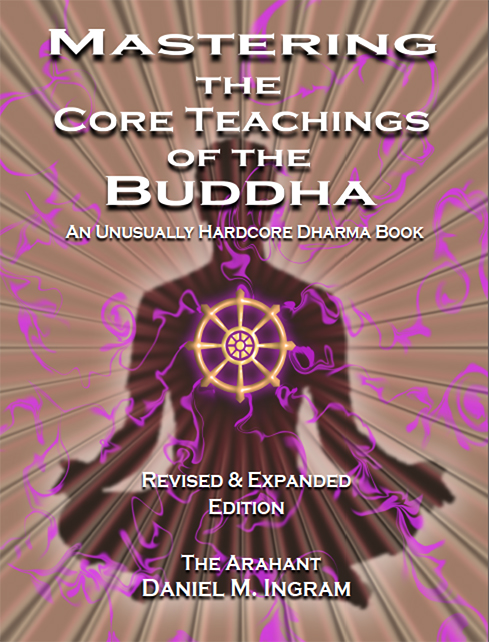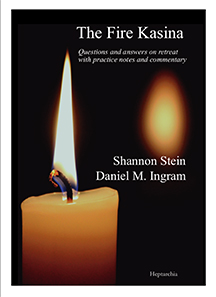3. The Three Characteristics
← 2. Cause and Effect | 4. The Arising and Passing Away →
The three characteristics of impermanence, unsatisfactoriness, and no-self become predominant, which is good, as these are the basis for insight, except this stage is one of the hard ones and can really throw people. It becomes more obvious that all the constituents of our experience are quickly arising and passing, somewhat jarring, and not particularly in our control or to be identified with as “me”. Further, as these sensations are all observed, including the crude mental impression that follows them (“consciousness”), it becomes clear the whole of the mind and body process is not a separate self; it is merely a part of the interdependent world.
These characteristics become clearer and clearer, as well as faster and faster, as the meditator diligently pays careful attention to exactly what is happening at each moment. For those doing noting practice, at this stage your speed and precision may get so fast that you cannot note every sensation you experience. Move to more general noting, monosyllabic noting (such as “bip” for each sensation experienced regardless of what it was), or drop the noting entirely and stay with noticing bare sensation come and go. If one is noting, then dropping noting during this stage will allow some to get much faster, but others will get sloppy, so watch for this, particularly around unpleasant sensations, and start noting again if you start to stagnate or regress.
At this stage, practice really begins to take off even though this stage tends to be physically unpleasant, with what is called “hard pain” being a classic hallmark of this stage. This stage can also cause many dark emotions and a sense of wanting to renounce the world and do only more practice. Others on retreat or practicing in daily life will hit the pain of this stage and completely bail out, because they find the hard pain frightening or too difficult to handle. Occasionally, the early part of this stage can cause people to feel vulnerable, raw, and irritable to the degree and in ways that a migraine headache or a bad case of PMS can. I have occasionally been laid out on a couch for hours by this aspect of this stage, holding my head, massaging my neck, and just wishing that these early stages didn’t sometimes involve so much pain, tension, and even anguish.
There may be odd bodily contortions, movements, obsession with posture, and painful tensions or other bizarre sensations, particularly in the back, neck, jaw, and shoulders, which typically go by the name kriyas in the Indian traditions. These tensions may persist when not meditating and be quite irritating and even debilitating. The rhomboid and trapezius muscles are the standard offenders. It is common to try to sit with good posture and then find our body twisting into some odd and painful position. Bizarre and even violent movements can occur. You straighten out, and soon enough the contortion happens again, often referred to as “swaying” in the Mahasi Sayadaw tradition, though it may be more rigid than that implies. This is a very Three Characteristics stage sort of pattern. People sometimes describe these feelings as some powerful energy that is blocked and wants to get out or move through.
Feelings of heat and sensations like those of a fever may sometimes accompany this stage. The neck and back may become very stiff, either on one side or both, specifically manifesting as spasmodic torticollis aka “wry neck” and/or TMJ pain. One day, the medical, developmental, psychological, and scientific disciplines will learn to recognize this insight stage with those being possible criteria. The right and left sides of the body may at times feel quite different from each other, like they are pulling in different directions, are somehow different sizes or shapes, or even have totally different feeling tones. The easiest way to get these unpleasant physical manifestations to stop is to keep investigating the three characteristics with high-resolution precision, of either the unpleasant sensations or of whatever primary object you have chosen.
These are common early retreat experiences, particularly in the first few days. A successful journey through this stage typically requires meditators to up their games in terms of the fine resolution of their minds. Our minds can perceive these tensions and unpleasant sensations with surprising degrees of speed and subtlety, if we can find the balance of positive meditation factors that facilitates this. A review of the seven factors of awakening may be helpful here.
Fighting the kriyas or trying other methods of alleviation (massages, painkillers, etc.) seems to help only a little, not at all, only temporarily, or sometimes makes the problem even worse, though sometimes hatha yoga, tai chi, and related practices done with a high degree of precise awareness can help. It is a common time for people on retreat to spend a lot of time suddenly stretching and reworking their sitting apparatus and posture to try to mitigate these effects, usually manifesting a few days into the retreat. This is a common time for people in daily life to go to health practitioners of various kinds, from orthopedists and dentists to chiropractors and body workers.
For example, I had a wisdom tooth removed during one pass through this stage because I thought it was throwing my jaw out of alignment. Perhaps it was, but this perception of the tooth’s position being pathological was clearly exacerbated by this stage of practice. I dream that one day chiropractors, physiatrists, physicians, mid-level practitioners, and physical, occupational, and massage therapists will all be taught these stages in school so that they can recognize them and help people cultivate some of the internal techniques that can help.
Even if these unpleasant physical manifestations do slack off for a bit, they are likely to recur until insight is sufficient to progress beyond this part of the stage of the Three Characteristics. Thus, should we find these meditation side effects interfering with our lives, I recommend continued precise and accepting investigative practice. This is a phase of practice in which strong effort and very quick investigation pay off.
Certain traditions may look at such physical manifestations as “energy imbalances” or in some other negative light, and I can see where they are coming from, but I find those perspectives limiting. Rather, I see this stage in its broader context as just one more phase of practice. Others may spin very strange tales to explain these experiences. A friend of mine ran into this stage on retreat, found it very unpleasant, stopped practicing, and began to create all sorts of fantastic stories in her head about how the poor fellow sitting next to her was very angry and how it was making her tense. This didn’t help whatsoever, and she got stuck there, her practice derailed by obsession with a story she had just made up. I have learned to welcome these odd manifestations as clearly recognizable markers of progress on the path. They are clear objects for practice and reassure me that I am on the right track. Unfortunately, this lesson is hard to teach others.
True, these manifestations are difficult, but being able to truly appreciate what is happening in the face of the difficult stages is important, and becomes much more important later. This stage can look like some similarly unpleasant later stages (the Dark Night stages, described shortly), and it is easy to confuse this stage with those later stages. This stage tends to be more physically painful and involve more muscular pathology, but sorting out which is which is often more a question of timing, sequence, and context, as some of the emotional tones can be very similar.
Bodily pains and tensions on one side more than the other naturally draw attention to that side. This is normal and understandable, but it can also cause problems. I highly recommend that you try to keep part of your attention focused on the other side of the body even when one side hurts a lot more and the other side seems to disappear into the background in contrast, to be boring, or to have nothing going on at all. Focusing too much meditative attention on one side of the body can cause all sorts of weird postural distortions and other odd meditative issues. Also, if one area hurts, it might be something on the other side, or just above or below it that is causing the trouble. For example, plenty of TMJ problems (jaw pain typically on one side) can be caused by the muscles on the other side of the head being too tight and throwing that joint off, but if you just focus on where the pain is most strongly sensed, you might easily miss what is causing it, as the side with the tense muscles often doesn’t hurt.
The back and neck are similar—you can have tension on one side that causes the other side to hurt. In short, whenever you have what seems to be isolated pain, check the other side and the surrounding areas to see if maybe there isn’t something subtler but related going on, as that can help. This lesson took me a long time to learn, so hopefully passing it on will save some time for you. Noticing anything subtly fluxing, vibrating, or changing about the pain and the surrounding areas can also help to loosen it up and move it.
As the mind gains speed at seeing each of the sensations of the mind and body come and go, the jerkiness from Cause and Effect can become very quick and pronounced. These physical movements and spasms seem to help break up the physical tension that may sometimes accompany this stage, and are a sign of progress and should be allowed if possible. If you are on retreat and start shaking, talk with the teacher and see if there is a place where you can sit and shake as much as you need to. Dealing with this stage’s sometimes strange physical effects can be troubling enough, without having to deal with the reactions of everyone around you.
I recommend neither cultivating the shaking nor restraining it (unless you need to keep from hurting yourself, as some of the movements can get pretty weird). Kriyas can be fascinating for some people for a while, like some odd spasmodic badge of accomplishment, but they are just low-level, early-stage, beginner stuff most of the time (though they can occasionally happen to more advanced meditators) and so shouldn’t be any source of pride. As you will see, there is much to perceive beyond them. Being all excited and proud about having body spasms is sort of like being all excited and proud about being in second grade. Chapter nine in A Path with Heart, by Jack Kornfield, is worth reading about the various odd effects that can occur, and for skillful advice on how to deal with them. There is a great set of techniques explained in Robert Harry Hover’s classic How to Direct the Life Force to Dispel Mild Aches and Pains that I recommend for this stage in particular, though the knowledge contained therein has many other applications. As that older book is hard to find, you can check out his memorably titled newer book, Internal Moving Healing Manual of Instruction: Stopping Your Pain & Other Unpleasant Things.
Regardless, as meditation begins to take on a life of its own, we enter the second vipassana jhana …

